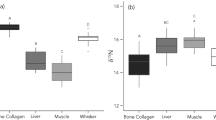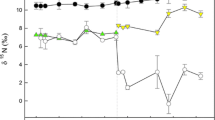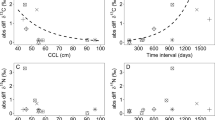Abstract
Changes in the nutritional status of free-ranging animals have a strong influence on individual fitness, yet it remains challenging to monitor longitudinally. Nitrogen (δ15N) and carbon (δ13C) isotope values measured chronologically along the length of metabolically inert keratinous tissues can be used as a nutritional biomarker to retrospectively reconstruct the foraging ecology and eco-physiology of consumers. We quantitatively describe the physiological effects of fasting on amino acid metabolism using sequentially measured bulk tissue and amino acid δ15N values along the length of whiskers sampled from free-ranging juvenile, subadults, adult female, and male southern elephant seals (SES; Mirounga leonina) on Marion Island in the Southern Ocean. For both juveniles and adult females, whisker segments representing fasting had significantly higher bulk tissue δ15N values of 0.6 ± 0.5‰ and 1.3–1.8‰, respectively, in comparison to segments unaffected by fasting. We also found a large increase (2–6‰) in δ15N values for most glucogenic amino acids and a simultaneous depletion (2–3‰) of alanine in segments reflecting fasting, which enabled us to accurately predict (74%) the nutritional status of our model species. We hypothesize that the glucose-alanine cycle is the mechanism driving the observed depletion of alanine δ15N values during fasting. We demonstrated that keratinaceous tissues can be used as a longitudinal nutritional biomarker to detect changes in the nitrogen balance of an individual. Moreover, it is evident that physiological factors have an important influence on tissue δ15N values and can lead to erroneous bulk tissue or amino acid isotope-based reconstructions of foraging habits.





Similar content being viewed by others
References
Adibi SA (1980) Roles of branched-chain amino acids in metabolic regulation. J Lab Clin Med 95(4):475–484
Aurioles-Gamboa D, Newsome SD, Hassrick JL, Acosta-Pachón T, Aurioles-Rodríguez F, Costa DP (2019) Use of 15N-enriched glycine to estimate vibrissa growth in free-ranging northern elephant seals Mirounga angustirostris. Mar Ecol Prog Ser 614:199–207
Boyd I, Arnbom T, Fedak M (1993) Water flux, body composition, and metabolic rate during molt in female southern elephant seals (Mirounga leonina). Physiol Zool 66(1):43–60
Bradley CJ, Madigan DJ, Block BA, Popp BN (2014) Amino acid isotope incorporation and enrichment factors in Pacific bluefin tuna, Thunnus orientalis. PLoS ONE 9(1):e85818
Carlini AR, Márquez MEI, Ramdohr S, Bornemann H, Panarello HO, Daneri GA (2001) Post-weaning duration and body composition changes in southern elephant seal (Mirounga leonina) pups at King George Island. Physiol Biochem Zool 74(4):531–540
Chikaraishi Y, Ogawa NO, Kashiyama Y, Takano Y, Suga H, Tomitani A, Ohkouchi N (2009) Determination of aquatic food-web structure based on compound-specific nitrogen isotopic composition of amino acids. Limnol Oceanogr Methods 7(11):740–750
Doi H, Akamatsu F, González AL (2017) Starvation effects on nitrogen and carbon stable isotopes of animals: an insight from meta-analysis of fasting experiments. R Soc Open Sci 4(8):170633
Downs EE, Popp BN, Holl CM (2014) Nitrogen isotope fractionation and amino acid turnover rates in the Pacific white shrimp Litopenaeus vannamei. Mar Ecol Prog Ser 516:239–250
Fantle MS, Dittel AI, Schwalm SM, Epifanio CE, Fogel ML (1999) A food web analysis of the juvenile blue crab, Callinectes sapidus, using stable isotopes in whole animals and individual amino acids. Oecologia 120(3):416–426
Fedak M (2004) Marine animals as platforms for oceanographic sampling: a "win/win" situation for biology and operational oceanography. Mem Natl Inst Polar Res 58:133–147
Felig P, Owen OE, Wahren J, Cahill GF (1969) Amino acid metabolism during prolonged starvation. J Clin Investig 48(3):584–594
Felig P, Pozefsk T, Marlis E, Cahill GF (1970) Alanine: key role in gluconeogenesis. Science 167(3920):1003–1004
Fontana L, Partridge L (2015) Promoting health and longevity through diet: from model organisms to humans. Cell 161(1):106–118
Fuller BT, Fuller JL, Sage NE, Harris DA, O'Connell TC, Hedges RE (2004) Nitrogen balance and δ15N: why you're not what you eat during pregnancy. Rapid Commun Mass Spectrom 18(23):2889–2896
Fuller BT, Fuller JL, Sage NE, Harris DA, O'Connell TC, Hedges RE (2005) Nitrogen balance and δ15N: why you're not what you eat during nutritional stress. Rapid Commun Mass Spectrom 19(18):2497–2506
Germain LR, Koch PL, Harvey J, McCarthy MD (2013) Nitrogen isotope fractionation in amino acids from harbor seals: implications for compound-specific trophic position calculations. Mar Ecol Prog Ser 482:265–277
Hatch KA (2012) The use and application of stable isotope analysis to the study of starvation, fasting, and nutritional stress in animals. Comparative physiology of fasting, starvation, and food limitation. Springer, Berlin, pp 337–364
Hertz E, Trudel M, Cox MK, Mazumder A (2015) Effects of fasting and nutritional restriction on the isotopic ratios of nitrogen and carbon: a meta-analysis. Ecol Evol 5(21):4829–4839
Hobson KA, Alisauskas RT, Clark RG (1993) Stable-nitrogen isotope enrichment in avian tissues due to fasting and nutritional stress: implications for isotopic analyses of diet. Condor 95(2):388–394
Hughes KL, Whiteman JP, Newsome SD (2018) The relationship between dietary protein content, body condition, and Δ15N in a mammalian omnivore. Oecologia 186(2):357–367
Jaeger A, Lecomte VJ, Weimerskirch H, Richard P, Cherel Y (2010) Seabird satellite tracking validates the use of latitudinal isoscapes to depict predators' foraging areas in the Southern Ocean. Rapid Commun Mass Spectrom 24(23):3456–3460
Jenkins SG, Partridge ST, Stephenson TR, Farley SD, Robbins CT (2001) Nitrogen and carbon isotope fractionation between mothers, neonates, and nursing offspring. Oecologia 129(3):336–341
Kalhan SC, Hanson RW (2012) Resurgence of serine: an often neglected but indispensable amino acid. J Biol Chem 287(24):19786–19791
Krebs H (1964) The metabolic fate of amino acids. In: Munro H, Ellison J (eds) Mammalian protein metabolism, vol 1. Academic Press, New York, p 1251
Le Boeuf BJ, Laws RM (1994) Elephant seals: population ecology, behavior, and physiology. University of California Press, Berkeley
Lee TN, Buck CL, Barnes BM, O’Brien DM (2012) A test of alternative models for increased tissue nitrogen isotope ratios during fasting in hibernating arctic ground squirrels. J Exp Biol 215(19):3354–3361
Lübcker N, Condit R, Beltran RS, de Bruyn PJN, Bester MN (2016) Vibrissal growth parameters of southern elephant seals Mirounga leonina: obtaining fine-scale, time-based stable isotope data. Mar Ecol Prog Ser 559:243–255
Lübcker N, Reisinger RR, Oosthuizen WC, de Bruyn PJN, van Tonder A, Pistorius PA, Bester MN (2017) Low trophic level diet of juvenile southern elephant seals Mirounga leonina from Marion Island: a stable isotope investigation using vibrissal regrowths. Mar Ecol Prog Ser 577:237–250
Macko SA, Estep MLF, Engel MH, Hare PE (1986) Kinetic fractionation of stable nitrogen isotopes during amino acid transamination. Geochim Cosmochim Acta 50(10):2143–2146
McCue MD (2010) Starvation physiology: reviewing the different strategies animals use to survive a common challenge. Comp Biochem Physiol A Mol Integr Physiol 156(1):1–18
McHuron EA, Holser RR, Costa DP (2019) What’s in a whisker? Disentangling ecological and physiological isotopic signals. Rapid Commun Mass Spectrom 33(1):57–66
McMahon KW, McCarthy MD (2016) Embracing variability in amino acid δ15N fractionation: mechanisms, implications, and applications for trophic ecology. Ecosphere 7(12):e01511
Mekota AM, Grupe G, Ufer S, Cuntz U (2009) Identifying starvation episodes using stable isotopes in hair. Rechtsmedizin 19(6):431
Muggeo VM (2008) Segmented: an R package to fit regression models with broken-line relationships. R news 8(1):25
Newsome SD, Clementz MT, Koch PL (2010) Using stable isotope biogeochemistry to study marine mammal ecology. Mar Mamm Sci 26(3):509–572
Nordhausen K, Oja H, Tyler DE (2008) Tools for exploring multivariate data: the package ICS. J Stat Softw 28(6):1–31
O’Connell TC (2017) ‘Trophic’ and ‘source’ amino acids in trophic estimation: a likely metabolic explanation. Oecologia 184(2):317–326
O'Brien DM (2015) Stable isotope ratios as biomarkers of diet for health research. Annu Rev Nutr 35:565–594
Ohkouchi N, Chikaraishi Y, Close HG, Fry B, Larsen T, Madigan DJ, Ogawa NO (2017) Advances in the application of amino acid nitrogen isotopic analysis in ecological and biogeochemical studies. Org Geochem 113:150–174
Peterson BJ, Fry B (1987) Stable isotopes in ecosystem studies. Annu Rev Ecol Syst 18(1):293–320
Petzke KJ, Fuller BT, Metges CC (2010) Advances in natural stable isotope ratio analysis of human hair to determine nutritional and metabolic status. Curr Opin Clin Nutr Metab Care 13(5):532–540
R Core Team (2018) R: a language and environment for statistical computing. R Foundation for Statistical Computing, Austria. 2016. https://www.R-project.org
Raubenheimer D, Simpson SJ, Mayntz D (2009) Nutrition, ecology and nutritional ecology: toward an integrated framework. Funct Ecol 1:4–16
Reitsema LJ (2013) Beyond diet reconstruction: stable isotope applications to human physiology, health, and nutrition. Am J Hum Biol 25(4):445–456
Secor SM, Carey HV (2011) Integrative physiology of fasting. Compr Physiol 6(2):773–825
Tom A, Nair KS (2006) Assessment of branched-chain amino acid status and potential for biomarkers. J Nutr 136(1):324S–330S
Vanderklift MA, Ponsard S (2003) Sources of variation in consumer-diet δ15N enrichment: a meta-analysis. Oecologia 136(2):169–182
Venables WN, Ripley BD (2013) Modern applied statistics with S-PLUS. Springer Science and Business Media, New York
Vidal N, González-Bergonzoni I, Naya DE (2019) The effect of fasting on nutritional status, organs size and isotopic composition in a Neotropical fish species (Jenynsia multidentata). Hydrobiologia 828:73–82
Wallace CJ, Hedges RE (2016) Nitrogen isotopic discrimination in dietary amino acids: the threonine anomaly. Rapid Commun Mass Spectrom 30(22):2442–2446
Wang W, Wu Z, Dai Z, Yang Y, Wang J, Wu G (2013) Glycine metabolism in animals and humans: implications for nutrition and health. Amino Acids 45(3):463–477
Whiteman JP, Elliott Smith EA, Besser AC, Newsome SD (2019) A guide to using compound-specific stable isotope analysis to study the fates of molecules in organisms and ecosystems. Diversity 11(1):8
Wilkinson IS, Bester MN (1990) Duration of post-weaning fast and local dispersion in the southern elephant seal, Mirounga leonina, at Marion Island. J Zool 222(4):591–600
Yun HY, Lampe JW, Tinker LF, Neuhouser ML, Beresford SA, Niles KR, O'Brien DM (2018) Serum nitrogen and carbon stable isotope ratios meet biomarker criteria for fish and animal protein intake in a controlled feeding study of a women's health initiative cohort. J Nutr 148(12):1931–1937
Acknowledgements
The Animal Use and Care Committee (AUCC) of the Faculty of Veterinary Science, University of Pretoria, provided ethical clearance for the research under AUCC 040827-022, AUCC 040827-023, EC030602-016, and EC077-15. We thank Prof Dan Costa (University of California, Santa Cruz, USA) for his vital role with the sample handling [National Marine Fisheries Service (NMFS), National Oceanic and Atmospheric Administration (NOAA) Permit number 19439]. The National Research Foundation (NRF) (Grant no. SFH14070373490) funded the research and supported N. Lübcker through an Innovation Scholarship. The ‘Society for Marine Mammalogy (SMM) Small Grant in Aid of Research’ provided additional support for the sample analyses. The conclusions drawn are attributed to the authors and not necessarily to the NRF and SMM. Logistical support was provided by the Department of Environmental Affairs under the South African National Antarctic Program (SANAP). We express our sincerest gratitude towards the staff and colleagues at the University of New Mexico Center for Stable Isotopes (Albuquerque, NM, USA) for their support, with a special mention for Dr. Viorel Atudorei and Emma Elliot Smith, as well as to Dr. Grant Hall, Nicolas Prinsloo, Michael Mole, and André van Tonder and field personne from the University of Pretoria, South Africa. Lastly, we thank the reviewers for their time and valuable contributions.
Author information
Authors and Affiliations
Contributions
NL, SDN, RPM, JPW, and PJNdB conceived and designed the experiments. PJNdB, JPW, SDN, and RPM enabled sample collection and sample analyses. NL and JW analysed the data. NL wrote the manuscript; other authors provided editorial advice.
Corresponding author
Ethics declarations
Conflict of interest
The authors declare that they have no conflict of interest.
Ethical approval
All procedures performed in the studies involving human participants were in accordance with the ethical standards of the institutional and/or national research committee and with the 1964 Helsinki declaration and its later amendments or comparable ethical standards.
Additional information
Communicated by Helene Marsh.
Electronic supplementary material
Below is the link to the electronic supplementary material.
Rights and permissions
About this article
Cite this article
Lübcker, N., Whiteman, J.P., Millar, R.P. et al. Fasting affects amino acid nitrogen isotope values: a new tool for identifying nitrogen balance of free-ranging mammals. Oecologia 193, 53–65 (2020). https://doi.org/10.1007/s00442-020-04645-5
Received:
Accepted:
Published:
Issue Date:
DOI: https://doi.org/10.1007/s00442-020-04645-5




